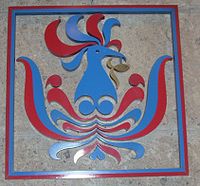- Maranao people
-
Maranao 
Sarimanokis a legendary bird of the Maranao that has become a ubiquitous symbol of their art Total population 1,142,000
1.25% of total populationRegions with significant populations Bukidnon, Cotabato, Lanao del Norte, Lanao del Sur, Maguindanao, Zamboanga del Sur, Basilan, Sulu, Tawi-tawi, Manila, Cebu in the  Philippines
Philippines
Maranaos in USA – United States
United States
Maranao in Saudi Arabia[1] – Saudi Arabia
Saudi Arabia
Middle East
Languages Religion Predominantly Islam
Christian minority existsRelated ethnic groups Illanun, Maguindanao, Tiruray
Lumad, Visayan,
other Moros,
other Filipino peoples,
other Austronesian peoplesMaranao is the term used for the people of Lanao, a predominantly Muslim region in the Philippines island of Mindanao. They are famous for their artwork, sophisticated weaving, wood and metal craft, and their epic literature. The word Maranao, also spelled Maranaw, means "People of the Lake,"[2][3] referring to the indigenous people who inhabited the lands around Lake Lanao whose principal town is Marawi City. The Maranaos are part of the wider Moro ethnic group, who constitute the sixth largest Filipino ethnic group.
Contents
Culture and Custom
Language
- Maranao is an Austronesian language spoken by the Maranao people in the provinces of Lanao del Norte and Lanao del Sur in the Philippines.[4][5]
Art
- Sarimanok is a legendary bird of the Maranao that has become a ubiquitous symbol of their art. It is depicted as a fowl with colorful wings and feathered tail, holding a fish on its beak or talons. The head is profusely decorated with scroll, leaf, and spiral motifs. It is said to be a symbol of good fortune.[6][7] 2.
Musical Heritage
-
Main articles: Music of the Philippines and Kulintang
- The native Maranao have a fascinating culture that revolves around kulintang music, a specific type of gong music, found among both Muslim and non-Muslim groups of the Southern Philippines. Biyula is another Instrument for the Maranao people to use, Biyula is a string instrument. In 2005, the Darangen Epic of the Maranao people of Lake Lanao was selected by UNESCO as a Masterpiece of the Oral and Intangible Heritage of Humanity.
Cuisine
- Exquisite Maranao cuisine and hospitality are palpable.[8] They are known of having a spicy taste in their foods. A condiment made of traditionally cultivated spices, locally known as Palapa is one of their distinguished cuisine symbol. It is made of stewed scallion bulbs or “sakurab” in Maranao. The thinly sliced scallion bulbs and ginger are caramelized by slow cooking and mixed with chillies and little coconut oil.[9]
- Maranao recipes are so rich that it talks about life itself! Suffice it to say that the recipes are intertwined with the life cycle rites and rituals of all aspects of Maranao society and culture: from birth to death. In other words, food cannot be separated with daily life activities because food is life itself![10]
The Legend of Maranao Food
- According to a scholar, food is one of the panabi-nabian, prophet, a mercy and a gift from Allah. "When the world was created, mankind had no food to eat. The soil was asked to feed mankind but it refused because it does not have enough to feed mankind. And so one of the sons of Fatima, Asa, was buried so that Nabi Adam will also be fed and be able to move. For seven days Nabi Saopak was buried. After seven days, it grew. On the head part grew a coconut, on the heart grew the palay, on the pelvis grew cotton, and on the lower art grew a white chicken. The palay was harvested and fed to mankind."[10]
Demographics
Maranaos number about 1,142,000. Along with the Illanun and Maguindanao, the Maranao are one of three related indigenous Muslim groups native to the island of Mindanao. In turn, these groups also share genes, linguistic and cultural ties to non-Muslim Lumad groups such as the Tiruray or Subanon. Maranao royals have varied infusions of Arab, Indian, Malay, Javanese, as well as Chinese ancestry.
The language of the Maranao people is also called Maranao. It is a language spoken by approximately 1,142,000 people living in areas near Lanao del Sur and Lanao del Norte.[5] The language can be traced from the Southern Philippine sub-branch of the Western Austronesian language family, and is closely related to the Illanun language spoken in Sabah and Malaysia. It is also close to Maguindanaon, the language spoken in Maguindanao, North Cotabato, South Cotabato, Sultan Kudarat, and Zamboanga del Sur provinces. They speak Cebuano, Tagalog, and Arabic language, and English as second languages. Practically, all Maranaos are Muslims. A few, especially those living in the hills around Lake Lanao practice a version of Islam mixed with traces of pre-Islamic traditions.
History
Previous to the occupation of the Philippines by Spanish, and later American and Japanese, the Maranaos had their own kingdom with a Sultan ruler due to the influence of Muslim missionaries.
Notes and References
- ^ Maranao.Com Federation of Maranao Associations in Saudi
- ^ Maranao Online About Maranaos
- ^ Ranaw.Com Welcome to Lanao del Sur ( RANAW )
- ^ Iloko Blog Website accessed on 21 October 2010
- ^ a b Maranao.Info Website accessed on 21 October 2010
- ^ Sarimanok an ubiquitous symbol of Maranao Art
- ^ Recipes in the Life of the Maranao
- ^ Cerphin.Net Rich and royal Lanao del Sur. Website accessed on 22 October 2010
- ^ Inquirer.Net Munai spice may be way out of war for conflict areas
- ^ a b Aratawata.Com Recipe in the Life of the Maranao. Website accessed on 21 October 2010
External links
- Maranaw
- Maranao Online
- Ranaw, Ranao (Lake) terms for Lanao del Sur.
The Moro | Bangsamoro Bajau • Banguingui • Illanun • Maguindanao • Maranao • Samal • Sangir • Tausug • Yakan Categories:
Categories:- Moro
- Muslim communities
- Islam in the Philippines
- Muslim communities of the Philippines
Wikimedia Foundation. 2010.
